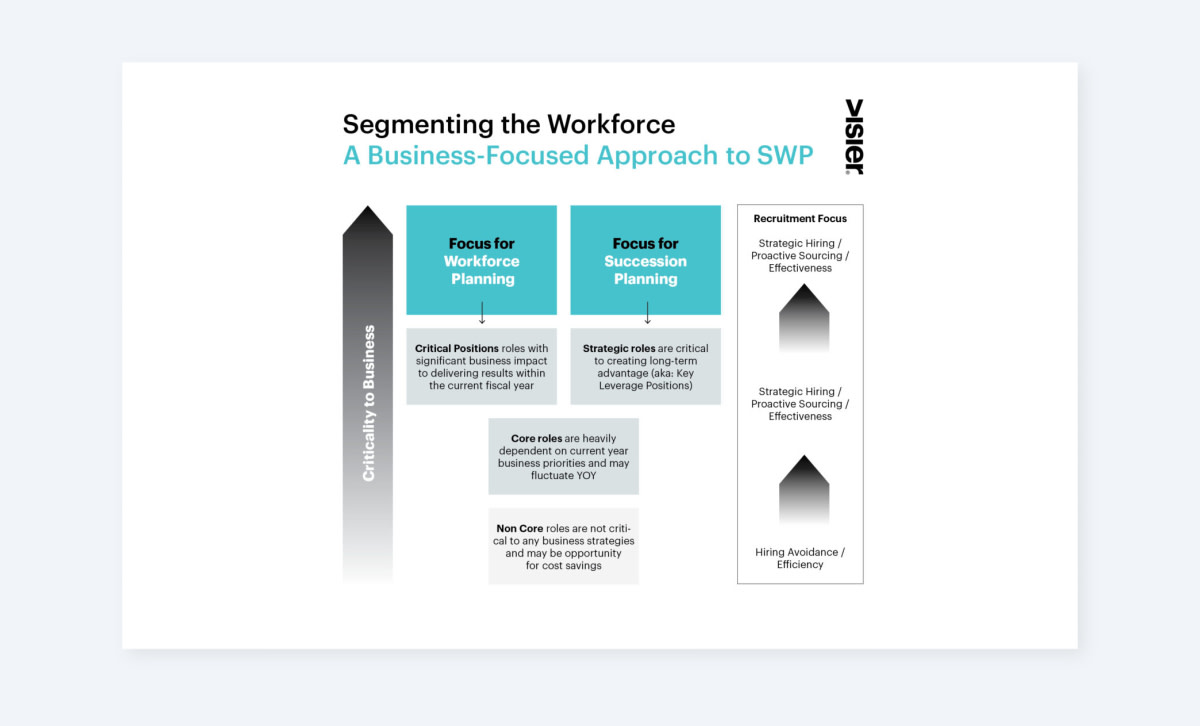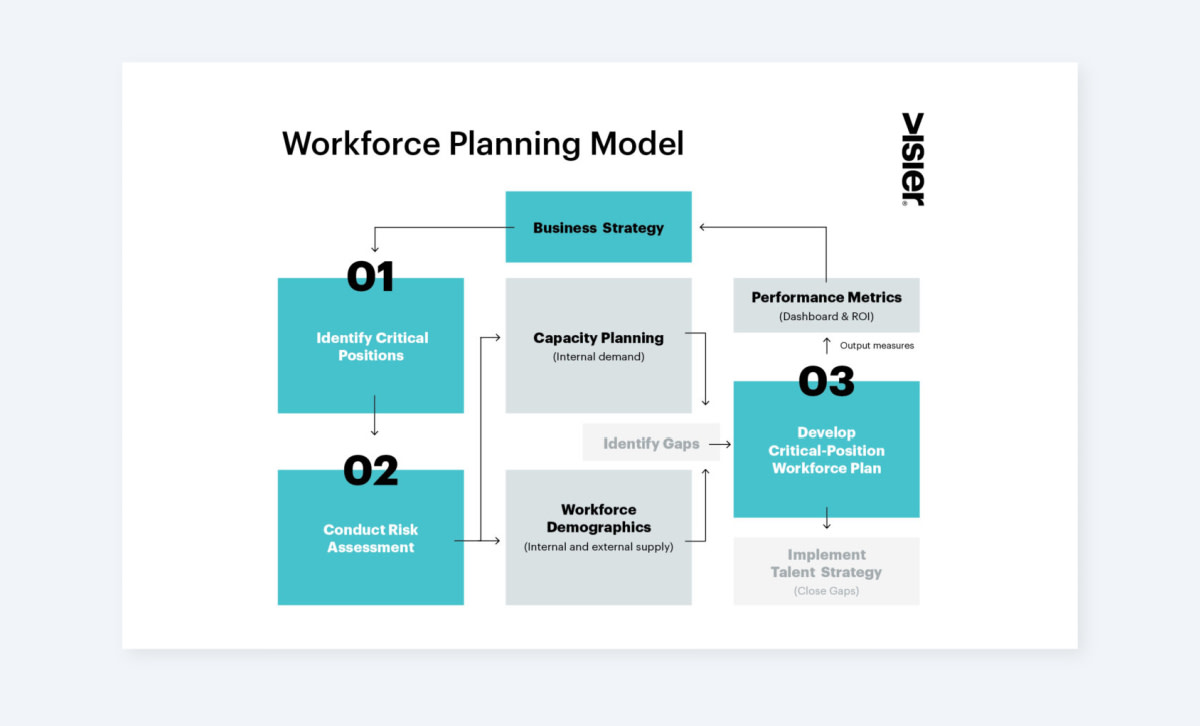Right-Sizing the Workforce for a New Reality
New workforce planning best practices emerging as businesses pass the reactive phase of the COVID-19 crisis. Learn more about rightsizing.

Navigating changes to your workforce is challenging but with strategic planning and workforce data, you can minimize the impact on business and your people.
The current unemployment numbers paint a grim picture–but not every organization is cutting back. Amazon, for example, is going through a hiring boom. Other businesses are simultaneously experiencing both an increase and a decrease in demand for different types of talent.
As organizations grapple with the new reality, we are seeing a focus on operational workforce planning (looking three to 12 months ahead). This is very different from strategic workforce planning, which typically looks anywhere from three to 10 years into the future. Aligning headcount supply with a longer term business vision is complex–but so is the kind of here and now planning that is going on these days.
To start, there is the human dimension to think about: putting people first takes on a whole new meaning during these extraordinary times. Because we are in the midst of a public health crisis that impacts absolutely everyone, leaders want to ensure they are doing the right thing for their employees, their families, and their communities. Avoiding job cuts whenever possible requires thoughtful risk-taking tactics.
Rightsizing vs. downsizing
At surface level, rightsizing and downsizing may appear to be the same, but this isn’t the case. Understanding the differences between the two is critical for organizations that want to focus on strategic workforce planning and make the best decisions for their company. Here’s a closer look at these strategies:
Downsizing
Downsizing is the permanent reduction of people in your workforce by terminating employees or eliminating some departments. The primary goal when organizations downsize is to cut costs and this action is often taken during an economic downturn in an effort to improve the bottom line. However, this is not always the right solution and it can have negative consequences long-term.
Rightsizing
The practice of rightsizing, in contrast, isn’t just about cutting costs. The goal here is to make the workforce more efficient. While this may include job cuts, the focus is on more strategic planning and reorganizing the workforce and upper management to streamline operations.
Managing rightsizing (making sure you have the right people in the organization and cost constraints with the need for more, less, or different talent) is particularly challenging when the future is so uncertain. Striking the right balance is key to saving money and most importantly, minimizing the impact on people.
Responsible rightsizing: The role of people data
Now, more than ever, HR leaders need the right people data so that they can quantify where the organization sits in terms of skills, roles, and operational requirements. It may seem counterintuitive, but a precise understanding of cost constraints and talent capacity can actually lead to more creative thinking.
Below are some specific best practices that we are seeing emerge as organizations move out of the reactive phase of the crisis. These best practices have been woven into a series of steps that organizations typically follow in the workforce planning process:
Step 1: Determine the business impacts
Getting to the point where you can say that your organization needs to pull back, expand, or even stay the same size but restructure is the output of a lot of work. It all starts with an in-depth understanding of how COVID-19 is impacting your business.
Right now, proactive HR professionals are having critical conversations with their business leaders. They are determining how the bottom line is being impacted, and looking at what this means from a people perspective. Here are just a few of the questions they are asking:
What are the immediate and longer term impacts on demand?
You could be experiencing both reductions and increases in demand. For example, projected revenues from your storefront operations may be virtually non-existent, meaning you do not need staff in this area. However, you may be ramping up your e-commerce lines of business, which requires you to move existing people into new roles or even hire.
Another factor to consider is the shelf-life of your product. Gourmet food items are probably not selling like hotcakes right now. But on the other hand, you want to be prepared for when buying patterns change again. This means you will need people in different production facilities at different times to ensure that employees are trained and properly prepared to quickly start-up production cycles once the consumer market has returned to normal. You may have to determine if a furlough is a better solution vs. a layoff. Paying for benefits continuance may be a better option given that terminating and hiring people is also very costly.
Are we temporarily shifting business focus? How?
Ford and GM have moved from making cars to ventilators. Breweries are making hand sanitizer. Restaurants are catering, delivering and preparing meals for take out instead of dine-in service, creating a need for more culinary staff and perhaps drivers in place of servers. In each of these cases, leaders need to understand quickly what types of new skills (and at what volume) are needed to make the new products or delivery processes that are in demand. By understanding how your business focus is changing, you will be in a better position to adjust your workforce accordingly.
Step 2: Identify who is in a critical role
For all organizations, this is a fundamental step, not only to help you determine who you need to keep, but also valuable when trying to assess where you need to shift resources.
One consumer health division of a large multinational organization, for example, is using data analytics to source the best matched talent from a global talent pool to support production of medical devices in aid of the COVID-19 response. Another health organization is using their data to identify staff members who can operate ventilators so they deploy them to hospitals that need them. By gaining visibility into employee profiles and talent data, they can make better decisions to shift resources to new areas of the organization.

To determine what a critical role is, ask these questions:
How critical is this role to the business?
A person is critical if they are crucial to the business functioning day to day. Do these people have a direct impact on your ability to deliver your business plan? If these individuals are responsible for any direct input to producing the goods or services that customers are currently demanding, you will need to hold on to them. This could include certified technicians or janitorial staff who are required to keep your operations running.
Does the position protect us from risk?
When certain positions are vacant, it may cause you to be noncompliant with internal policies or external regulations that result in a fine, penalty, or damaged brand. You would be justified in keeping people fully employed in these roles to avoid being exposed to a much greater expense in the future.
How hard is it to fill these positions?
The other category of must-keep positions are critical positions that are hard to replace. Talent shortages for skilled positions that require certifications or specific technical skill sets– such as an electrical engineer or psychologist–were a growing concern before COVID-19. Even if people in these positions can’t work remotely and they can’t be on the ground, you may want to retain them so that you are not struggling to hire for these positions in the future.
Step 3: Define specific operational requirements
The next step is to quantify finer details such as work from home equipment and details around work contracts.
How many people can be productive from home?
The technology supporting remote work has been around for a long time–but organizations have lagged behind in adoption, due to traditional ideas about what gets in the way of productivity. Now, many business leaders who previously had reservations about remote work have no choice but to support it. In this respect, proactive HR leaders are asking specific questions to get managers thinking about what is feasible from a task perspective, and not letting productivity concerns get in the way. Once these barriers are resolved, there’s a great opportunity to include remote, telecommuting and job sharing in the long-term workforce strategy for expense saving continuance.
Do we have the proper equipment and resources to allow a lot of people to work from home?
This is another question that is coming up. Many organizations are already equipping their knowledge workers with laptops and have a cloud computing infrastructure. For others, the adjustment isn’t quite so easy. There’s a cost around the type of equipment that you have to have in order to be able to make something like this happen. Work closely with your IT department on this end.
What is our Total Cost of Workforce?
You need to understand your Total Cost of Workforce (TCOW), which is the full cost for people who contribute work to the organization, including all of the labor costs and the workforce overhead costs. Why is knowing your current TCOW important when things are going to change anyway? Because it gives you an understanding, with a great degree of accuracy, of what changes will mean to your business financially. Using data analytics offers you the flexibility in terms of modeling various cost scenarios to make the best financial decisions, such as deciding on which locations to keep open or the value vs. effort for opening a new product line, based on costs. Read on for more scenario modeling tips.
Step 4: Model scenarios
Now it ’s time to get creative. For example, if a significant proportion of your workforce is facing childcare issues, you could explore job sharing programs, and whether that would enable you to keep more people. You could also consider training people who may have the right skillset to perform certain functions outside of their current position that are now in demand. What if you need to change shifts or work schedules? Or maybe it makes sense to approach your competitors about a combined initiative to keep as many people employed as you possibly can.
Scenario modeling allows you to take stock of what these creative ideas look like in terms of cost and talent capacity. It’s a good idea to have several scenarios that span the spectrum of what is generally sustainable for your business so that you are exploring all the viable options. Nobody is certain how long this recession will last.
Running multiple scenarios is simply too time consuming with spreadsheets. Oftentimes, information is spread across the organization in siloed systems within various departments and is difficult to aggregate and reconcile. To make this process easier, HR leaders can look for technology and tools that enable them to create and compare different workforce planning scenarios, looking at various timelines to align with short- and long-term predictions.
Step 5: Plan continuously
As you begin to execute your plan, different situations may come to light. You may find, for example, that you needed 25 people in a certain role, but only 15 of them can work from home on a full-time basis. Your absenteeism and attrition rates may also be different than expected.

So that you can adapt, rapid cycle planning is key. Using traditional methods, HR pulls information from many disparate systems (covering everything from compensation and performance data to financial targets). This can take a significant amount of time, which means that rapid-cycle planning is simply not feasible. Look to automate the task of manually pulling data from disparate systems so you can enable continuous monitoring and planning capability with reliable data.
By letting the technology do the work for you, you can stay focused on what is truly important: Developing a validated story to sustain your business and making sure that your employee value proposition is alive and well.
Share your people data insights
Share insights, ask questions, and discover the latest best practices on crisis management and employee safety using people analytics via the #AskVisier LinkedIn community
Get Outsmart content straight to your inbox
Subscribe to the People Insights Monthly newsletter for actionable insights and stories.
Subscribe now